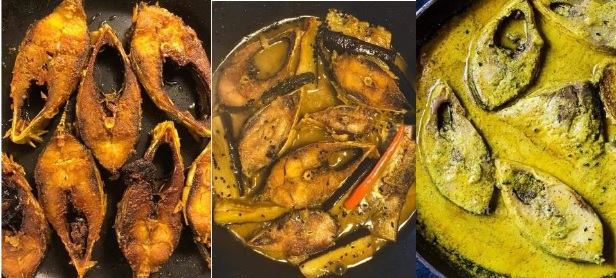
High on Hilsa(Eeleesh), today I invited myself to honor this fish that is so rich in flavor, texture and character that it commands a respectful submission from the cook before he starts dealing with it. Yes, Hilsa is a big deal indeed! At Least in Bengal, where it can be a conversation starter, a subject of debate, cynosure of a menu or a pride bordering on Nationalism, often earning the disrepute of a single story. A simple question of ‘‘Where to fetch the best Hilsa from?” can tug a war of words among Bengali fish lovers and self-appointed custodians of Bengali heritage.
Much of it has to do with the Bangaal vs Ghoti (people of West Bengal Origin vs. East Bengal Origin) lineage of fetching and cooking this fish. Much like our sharp preferences for football clubs- Mohun Bagan vs East Bengal- the opinion of best variety and origin of this silver water-crop is perennially divided between Ganga and Padma. However, irrespective of the differing views, the truth is, the shimmering beauty of this fish ripples through the cultural fabric of both parts of Bengal alike.
Concluding Hilsa just as a fleshy delight will be a disservice to this crusader of sorts that makes a long journey from choppy high seas to sweet river waters to finally reach the high tables a metaphoric journey that’s reminiscent of the mass migration of Bengalis from East of Bengal to the West during the febrile climate of partition.
Fried, Stewed, Curried or Mashed, each recipe unfolds flavors of different kitchens at different times of history. Recipes range from the kitchens of erstwhile elites of Bengal to make-shift kitchens of displaced Bengali families during partition, to the present day experimental kitchens of Bengal.
My parental lineage goes back to the hinterlands of East Bengal and along with other preserved rituals, cooking Eeleesh is a major event at home.
Starting from its origin, hue, cut and the size to choosing the complimentary vegetables for the curry, it takes a seasoned pair of eyes to get everything on point. In our family, my father was trusted with this task which later manifested into a feast in mum’s kitchen.
In elegance and grandeur, Bengal’s Eelish Maach squeaks past its other counterparts and is a close contender for Mutton Curry when on the same menu, because of its seasonal availability.
However, unlike the popular belief, Hilsa doesn’t make the top pick among many fish lovers in Bengal. As enigmatic as it may sound, there’s nothing graceful about deboning this bony fish. While for some, it’s an acquired taste, for many it is still a distant flavor. As for me, I can eat, live, and dream fish and I am blessed with a set of jaws that can decimate the boniest constitution into obscurity- something I inherited from my Didun, who I watched chewing on Dantaa (Drumsticks) and fishbone with similar dispassion. Not sure if she was meditative on the taste or chewed on some distant memory!
Important Note: One must also note that overfishing of this species during and at off-season has caused a serious depletion in its numbers and is an urgent concern today. Time and again strict fishing bans across the various habitats of Hilsa have been imposed in order to allow sufficient spawning, which eventually resulted in lesser supply in the market, shooting prices and a disrupted sustenance chain of Hilsa population- fishermen’s business and fish-seller’s profits. I hope a balance can be struck by a watchful management of all the factors affecting sustainability of man and environment.
Disclaimer: The views above are personal and can differ from the general sentiments of many Bengalis.